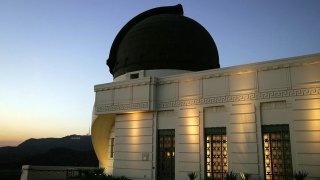
What to Know
- Wednesday, May 26
- The broadcast begins at 1:45 a.m.; peak eclipse will occur at 4:19 a.m.
- Free to watch
Wending your way through the shadowy and sublime turns of Griffith Park, late at night, all to enjoy a rare astronomical occurrence with a Griffith Observatory astronomer at the helm?
It's a mind-expanding, knowledge-deepening, and spirit-lifting outing that plenty of Southern Californians have enjoyed, in-person, over the years.
But just because the universe-observing landmark remains closed to the public doesn't mean you can't find some of those same cosmic thrills during the upcoming lunar eclipse.
Get Southern California news, weather forecasts and entertainment stories to your inbox. Sign up for NBC LA newsletters.
Which means, yes: You can stay in your jammies for the observatory's overnight live stream, which begins, locally, at 1:45 a.m. on Wednesday, May 26.
Note that the 1:45 a.m. broadcast kick-off isn't when the umbral event actually starts; you'll want to tune in around 2:45 a.m. for when the moon-marvelous show actually commences.
The "maximum eclipse" moment?
That's at 4:19 a.m. which is sort of the exact time between night and morning, making it an especially poetic moment for peak eclipse to occur.
Of course, poetry, while present in every eclipse, isn't the reason behind the high-in-the sky happening.
Griffith Observatory shares this: "A total lunar eclipse occurs when the Moon passes completely into the shadow cast by the Earth. The round disk of the full Moon slowly moves into the dark shadow, and the bright Moon grows dim. The Moon does not, however, become completely dark."
"Instead, it usually glows with a faint copper or red color, a result of sunlight being filtered and bent through the Earth’s atmosphere (much like a sunset)."
"The lunar eclipse is visible throughout southern California and can be seen easily with the unaided eye, though telescopes or binoculars may enhance the view."
If you choose to instead catch your winks, and sleep right through the spectacle, there's no need to be as blue as a blue moon: There's another total lunar eclipse on the way, or, rather, on-the-way-ish: In just under a year, on May 15-16, 2022, the moon and sun will again do their timeless shadow dance.
And perhaps we'll be back up the hill, at Griffith Observatory, watching it all together while we're gathered in front of the famous Art Deco building, which recently marked its 86th birthday?
Call it a perfectly poetic thought for a poetry-filled astronomical event.



